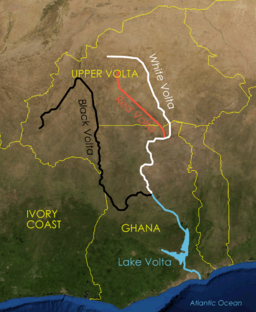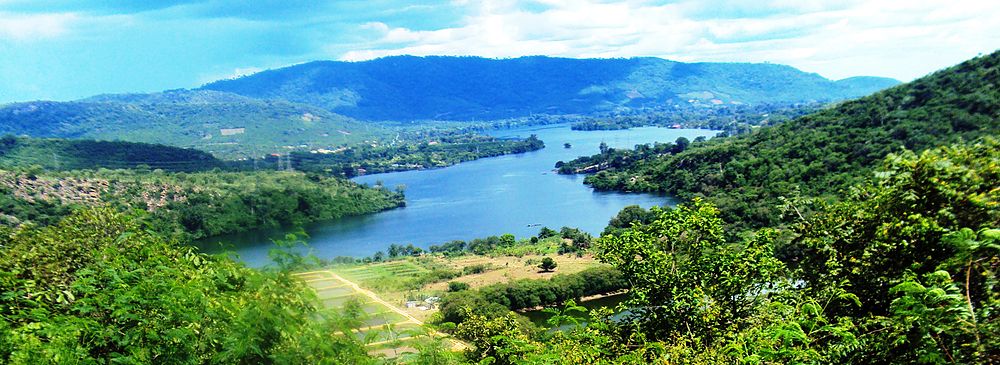Lake Volta
| Lake Volta | |
|---|---|
 View of Lake Volta and Adomi bridge | |
 Lake Volta in Ghana | |
| Location | Ghana,West Africa |
| Coordinates | 6°30′N0°0′E/ 6.500°N 0.000°E |
| Lake type | Reservoir |
| Primary inflows | White Volta River Black Volta River |
| Primary outflows | Volta River |
| Catchment area | 385,180 km2(148,720 sq mi) |
| Basincountries | Ghana |
| Surface area | 8,502 km2(3,283 sq mi) |
| Average depth | 18.8 m (61 ft 8 in) |
| Max. depth | 75 m (246 ft) |
| Water volume | 148 km3(32.6 × 1012gallons) |
| Shore length1 | 4,800 kilometres (2,980 mi) |
| Surface elevation | 85 m (279 ft) |
| 1Shore length isnot a well-defined measure. | |
Lake Volta,thelargest artificial reservoir in the world based on surface area,is contained behind theAkosombo Damwhich generates a substantial amount of Ghana's electricity. It is completely within the country ofGhanaand has a surface area of 8,502 square kilometres (3,283 sq mi).[1]It extends fromAkosomboin the south to the northern part of the country.[2][3]
Geography
[edit]Lake Volta lies along theprime meridian,six degrees north of theEquator.The lake's northernmost point is close to the town ofYapei,and its southernmost extreme is at theAkosombo Dam,520 km (320 mi) downstream from Yapei. Akosombo Dam holds back both theWhite Volta Riverand theBlack Volta River,which formerly converged where the middle of the reservoir now lies, to form the singleVolta River.The present Volta River flows from the outlets of the dam's powerhouse andspillwaysto theAtlantic Oceanin southern Ghana.
The main islands within the lake areDodi,Dwarf, and Kporve.[4]Digya National Parklies on part of the lake's western shore.
History
[edit]The lake was formed by theAkosombo Dam,which was originally conceived by the geologistAlbert Ernest Kitsonduring the British colonial period in 1915, to exploit the river's energy for smeltinglocally-sourced bauxite.The idea regained prominence at the end of the colonial era after theWorld War IIwhenKwame Nkrumahbecame president of theGold Coast colonyand began striving for modernization of the land. British and local governments formed a joint preparatory commission, which concluded that over 60,000 people will have to be relocated, but that the lake will boost opportunities for fishing, thus helping to feed the population in the region. On the other hand, issues with water-related illnesses were predicted, such asmalaria,trypanosomiasis,schistosomiasis,andonchocerciasis.[5]

Aluminium Limited, the main industrial sponsor of the project, withdrew after Ghana became independent in 1957. Revised plans dropped the idea of integrated aluminium industry and proposed smelting importedbauxiteinstead.Kaiser Aluminumentered the project at this point and after protracted negotiations, funding for the project was secured, but now without regard to residents of the impacted area as a cost-cutting measure. Construction thus began before the government started planning the resettlement. Soon after, a public agency was established, and organized construction of 52 replacement towns, which were envisioned to serve as a model for modernization and improving the livelihood of the local population. But because of the rush, the resettlement in 1964 turned out to be chaotic and inefficient. Poor organization caused the issues to continue long after the project's completion and caused significant hardship to the local population.[5]Together, 15,000 homes in 740 villages were flooded, necessitating resettlement of 78,000 people.[1]
In the long run, formation of the lake disrupted traditional fishing and farming practices in the region and caused a large spike in disease prevalence. Government-led modernization did not succeed, and people had to adapt to the new circumstances themselves.[5]However, regional food production intensified in the decades after the construction of Akosombo dam, and the lake also opened a large navigable pathway to the north of the country and provided new opportunities for development oftourismwhich is gaining in prominence. On the other hand, water level has been decreasing recently because ofglobal warming,reducing power generation.[6]
Economy
[edit]TheAkosombo Damproduces 912 MW of electricity for the country, as well as for export toTogo,Benin,and other nearby countries to earn foreign exchange.[1]Lake Volta is also important for transportation, providing a waterway for bothferriesandcargowatercraft. Since the huge lake lies in a tropical area, the water remains warm year-round naturally. Given goodmanagement,Lake Volta is the location of a vast population of fish and large fisheries.
The lake also attractstourism,and tourist cruises visit the island ofDodi.[4]
Recent developments include a large-scale enterprise to harvest submerged timber from the flooded forests under Lake Volta. This project harvests high-value tropicalhardwoodwithout requiring additional logging or destruction of existing forest and, according to Wayne Dunn, "could generate the largest source of environmentally sustainable natural tropical hardwood in the world."[7]In addition to generating foreign currency for the region and reducing the dependence of locals on fishing as a primary economic activity, the removal of submerged trees is improving navigation on the lake and increasing safety.[7]
An estimated 7,000 to 10,000 children work in the fishing industry on Lake Volta. The nature of their employment has been described asslaveryinThe Guardian[8]and by theCNN Freedom Project.This has been described assensationalismbyBetty Mensahand the academic Samuel Okyere since many of the children and youth whose wages are given upfront to their parents grow up to become self-sufficient fishermen in adulthood who in turn hire children themselves and could therefore also be characterized asapprentices.They conclude that many children may suffer under exploitative work but are not enslaved.[9][10]Despite not being officially enslaved, it is important to acknowledge the ethics and effects of child labor on physical, intellectual, and emotional development of children.[11]Additionally, children pose an interesting ethical dilemma around consent with regards to child labor, primarily driven by their existence as individuals separate from their parents with their own individual rights and needs.
Photos
[edit]-
A ferry on Lake Volta
-
Photograph of Lake Volta
-
AkosomboPort's signage
-
Trees in Lake Volta
See also
[edit]- Lake Kariba,the world'slargest reservoir by volume.
References
[edit]- ^abc"Lake Volta | lake, Ghana".Encyclopedia Britannica.Retrieved2021-02-06.
- ^"Lake Volta, Ghana".Visible Earth.NASA. 7 April 2002.Retrieved7 March2018.
- ^"Largest, Tallest, Biggest, Shortest".McqsPoint.Archived fromthe originalon 9 February 2019.Retrieved9 February2018.
- ^ab"Dodi Island cruises".secureserver.net.Archived fromthe originalon 2010-10-31.
- ^abcMiescher, Stephan F. (2021-10-01)."Ghana's Akosombo Dam, Volta Lake Fisheries & Climate Change".Daedalus.150(4): 124–142.doi:10.1162/daed_a_01876.
- ^Gyau-Boakye, P. (2001). "Environmental impacts of the Akosombo Dam and effects of climate change on the lake levels".Environment, Development and Sustainability.3(1): 17–29.doi:10.1023/A:1011402116047.
- ^ab"Harvesting an Underwater Forest".Archived from the original on March 4, 2012.Retrieved28 May2011.
{{cite web}}:CS1 maint: unfit URL (link) - ^"Sons for Sale".theguardian.22 March 2007.
- ^Okyere, Samuel (18 March 2019)."How CNN reported on 'child slaves' who were not really enslaved".AlJazeera.Retrieved30 July2019.
- ^"Ghanaian children wrongly taken in raids backed by US charity IJM".BBC News.July 10, 2023.
- ^https:// ncbi.nlm.nih.gov/pmc/articles/PMC6198592/
External links
[edit]- Lake Volta & Akosombo on Ghanaweb
- Volta Lake,International Lake Environment Committee Web site
- Gold exploration in the Volta region— Objective Capital Africa Resources Investment Conference (video)
- Lake Volta— more information on Ghana-Net








